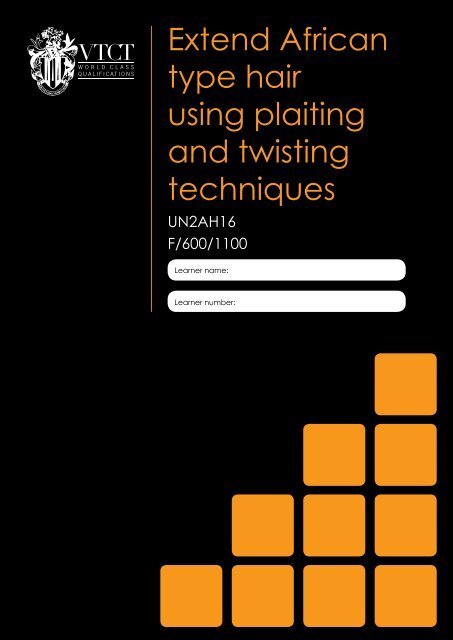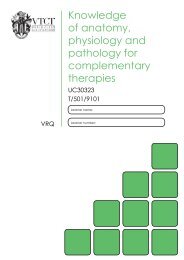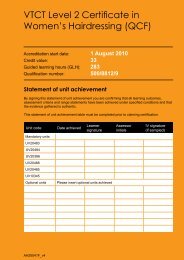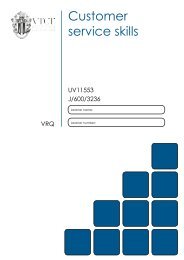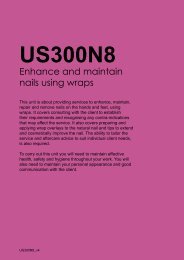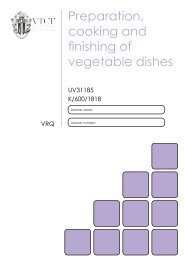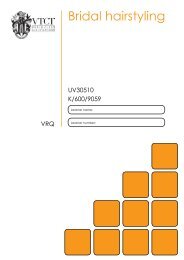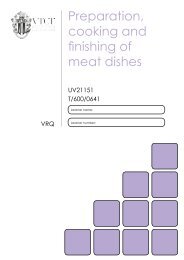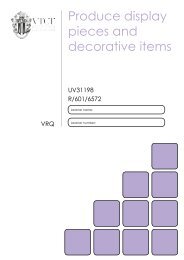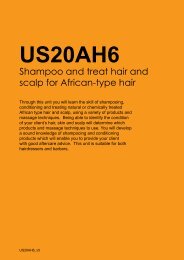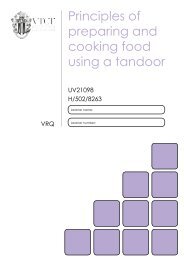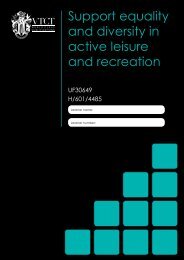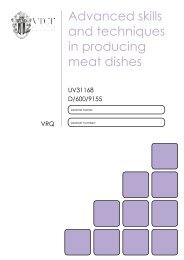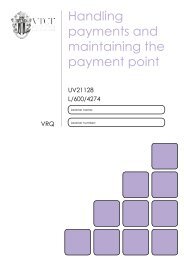UN2AH16 - VTCT
UN2AH16 - VTCT
UN2AH16 - VTCT
Create successful ePaper yourself
Turn your PDF publications into a flip-book with our unique Google optimized e-Paper software.
Extend African<br />
type hair<br />
using plaiting<br />
and twisting<br />
techniques<br />
<strong>UN2AH16</strong><br />
F/600/1100<br />
Learner name:<br />
Learner number:
Statement of unit achievement<br />
<strong>VTCT</strong> is the specialist awarding body for the Hairdressing, Beauty Therapy,<br />
Complementary Therapy and Sport and Active Leisure sectors, with over 45<br />
years of experience.<br />
<strong>VTCT</strong> is an awarding body regulated by national organisations including<br />
Ofqual, SQA, DCELLS and CCEA.<br />
<strong>VTCT</strong> is a registered charity investing in education and skills but also giving to<br />
good causes in the area of facial disfigurement.<br />
By signing this statement of unit achievement you are confirming that all learning outcomes, assessment<br />
criteria and range statements have been achieved under specified conditions and that the evidence<br />
gathered is authentic.<br />
This statement of unit achievement table must be completed prior to claiming certification.<br />
Unit code Date achieved Learner signature<br />
Assessor tracking table<br />
Assessor name Assessor signature<br />
Assessor<br />
initials<br />
Assessors<br />
initials<br />
IV signature<br />
(if sampled)<br />
All assessors using this Record of Assessment book must complete this table. This is required for<br />
verification purposes.<br />
Assessor number<br />
(optional)
<strong>UN2AH16</strong><br />
Extend African type hair using<br />
plaiting and twisting techniques<br />
Through this unit you will develop a variety of plaiting and<br />
twisting techniques for African type hair that incorporate<br />
the use of added hair. Being able to identify the condition<br />
of your client’s hair, skin and scalp will determine which<br />
products and technique to use. The preparation of your<br />
client’s hair, selecting blending and placing the extensions<br />
will add colour, length and volume for your client.<br />
Maintenance of the extensions and aftercare advice also<br />
form part of this unit.<br />
<strong>UN2AH16</strong>_v4
NOS<br />
AH16<br />
Level<br />
Credit value<br />
GLH<br />
2<br />
6<br />
54<br />
Observations<br />
3<br />
External paper(s)<br />
1
Extend African type hair using<br />
plaiting and twisting techniques<br />
Learning outcomes Evidence requirements<br />
On completion of this unit you will:<br />
1. Be able to use safe and effective methods<br />
of working when extending hair using<br />
plaiting and twisting techniques<br />
2. Be able to prepare the hair to be added<br />
3. Be able to produce plaited and twisted<br />
styles with added hair<br />
4. Know salon and legal requirements<br />
5. Understand how to work safely, effectively<br />
and hygienically when extending hair using<br />
plaiting and twisting techniques<br />
6. Know the effects of plaiting and twisting on<br />
the hair<br />
7. Understand the preparation requirements<br />
for added hair<br />
8. Understand plaiting and twisting techniques<br />
using added hair<br />
9. Understand products and their use<br />
10. Understand how to communicate and<br />
provide aftercare advice to clients on hair<br />
maintenance and management<br />
1. Simulation is not allowed for any<br />
performance evidence within this unit.<br />
2. You must practically demonstrate in your<br />
everyday work that you have met the<br />
standard for extending hair using plaiting<br />
and twisting techniques.<br />
3. Your assessor will observe your<br />
performance on at least 3 occasions.<br />
Each occasion must be of a different<br />
look.<br />
4. From the range, you must show that you<br />
have:<br />
• used all the products listed<br />
• created all the plaited and twisted styles<br />
listed<br />
• created all the types of plaits and twists<br />
listed<br />
• you have taken into account all the<br />
factors listed<br />
• used both sealing methods listed<br />
• given advice covering all the areas<br />
listed.<br />
5. It is likely most evidence of your<br />
performance will be gathered from the<br />
observations made by your assessor but<br />
you may be required to produce other<br />
evidence to support your performance if<br />
your assessor has not been present.<br />
6. Knowledge and understanding in this unit<br />
will be assessed by an external paper.<br />
The criteria that make up this paper are<br />
highlighted in white throughout this unit.<br />
There is one external paper that must be<br />
achieved.<br />
<strong>UN2AH16</strong><br />
3
4<br />
Achieving observations<br />
and range<br />
Achieving observation outcomes<br />
Your assessor will observe your performance<br />
of practical tasks. The minimum number<br />
of observations required is indicated in the<br />
evidence requirements section of this unit.<br />
Criteria may not always naturally occur during<br />
a practical observation. In such instances you<br />
will be asked questions to demonstrate your<br />
competence in this area. Your assessor will<br />
document the criteria that have been achieved<br />
through oral questioning.<br />
Your assessor will sign off an outcome when all<br />
criteria have been competently achieved in a<br />
single client service.<br />
Achieving range<br />
The range section indicates what must<br />
be covered. Ranges must be practically<br />
demonstrated as part of an observation. Your<br />
assessor will document the portfolio reference<br />
once a range has been competently achieved.<br />
<strong>UN2AH16</strong><br />
Maximum service times<br />
The following maximum service times apply to<br />
this unit:<br />
25% of multiple single plaits 120 minutes<br />
Over 15 multiple cornrows 90 minutes<br />
Full head of flat twists 120 minutes<br />
25% of Senegalese twists 120 minutes
Outcome 1<br />
You can:<br />
a. Protect the client’s clothing throughout the<br />
service<br />
b. Position the client and yourself to meet<br />
the needs of the service without causing<br />
discomfort and fatigue<br />
c. Keep the work area clean and tidy<br />
throughout the service<br />
d. Use working methods that:<br />
- minimise the risk of damage to tools<br />
and client’s hair<br />
- minimise the wastage of products<br />
- minimise the risk of cross-infection<br />
- makes effective use of working time<br />
- ensure the use of clean resources<br />
- minimise harm or injury to yourself<br />
and others<br />
e. Maintain personal standards of health<br />
and hygiene to minimise the risk of crossinfection,<br />
infestation and offence to clients<br />
and colleagues<br />
f. Complete the plaiting and twisting service<br />
within a commercially viable time<br />
*May be assessed through oral questioning.<br />
Observations<br />
Be able to use safe and effective methods of working when<br />
extending hair using plaiting and twisting techniques<br />
Observation<br />
Criteria questioned orally<br />
Date achieved<br />
Portfolio reference<br />
Learner signature<br />
Assessor initials<br />
1 2 3<br />
<strong>UN2AH16</strong><br />
5
6<br />
Outcome 2<br />
Be able to prepare the hair to be added<br />
You can:<br />
a. Consult with the client about the type, length<br />
and colour of added hair<br />
b. Select and use added hair which is:<br />
- of a suitable texture<br />
- of a suitable colour<br />
- evenly blended<br />
c. Divide and separate the added hair to avoid<br />
wastage and tangling<br />
*May be assessed through oral questioning.<br />
Observation 1 2 3<br />
Criteria questioned orally<br />
Date achieved<br />
Portfolio reference<br />
Learner signature<br />
Assessor initials<br />
<strong>UN2AH16</strong>
Outcome 3<br />
Be able to produce plaited and twisted styles with added hair<br />
You can:<br />
a. Consult with the client about their<br />
satisfaction with the agreed look, prior to,<br />
during and on completion of the service<br />
b. Part the sections cleanly and evenly to<br />
achieve the direction of the agreed plaited<br />
and or twisted style, securing any hair not<br />
being plaited or twisted<br />
c. Add a quantity of hair which gives a<br />
balanced and well proportioned look<br />
suitable for the density of the client’s hair<br />
d. Secure added hair into the client’s hair at<br />
the starting point of the section<br />
e. Use and adjust a suitable and even tension<br />
when creating plaits and twists, to make<br />
sure the direction of the plaiting and twisting<br />
takes into account influencing factors<br />
f. Incorporate all the client’s own hair and<br />
added hair in a way that achieves an even<br />
and smooth finish, making sure the direction<br />
and balance of the finished plaited and/<br />
or twisted style meets that agreed with the<br />
client<br />
*May be assessed through oral questioning.<br />
Observation 1 2 3<br />
Criteria questioned orally<br />
Date achieved<br />
Portfolio reference<br />
Learner signature<br />
Assessor initials<br />
g. Use sealing methods that safely secure the<br />
ends of the plaits and twists *<br />
h. Use suitable styling and finishing products,<br />
when necessary, at the right time in the<br />
process to achieve the style requirements<br />
i. Give the client suitable advice and<br />
recommendations on the maintenance of<br />
their plaited and or twisted style and hair<br />
condition<br />
<strong>UN2AH16</strong><br />
7
8<br />
Range<br />
You must practically demonstrate that you have:<br />
Used all the products Portfolio reference<br />
Sprays<br />
Oils<br />
Moisturisers<br />
Gels<br />
Created all the plaited and twisted styles Portfolio reference<br />
25% of multiple single plaits<br />
Maximum service time – 120 mins<br />
Over 15 multiple cornrows<br />
Maximum service time – 90 mins<br />
Full head of flat twists<br />
Maximum service time – 120 mins<br />
25% of Senegalese twists<br />
Maximum service time – 120 mins<br />
Created all the types of plaits and twists Portfolio reference<br />
Multiple cornrow with added hair<br />
Multiple single plaits with added hair<br />
Flat twist with added hair<br />
Senegalese twist with added hair<br />
<strong>UN2AH16</strong>
You must practically demonstrate that you have:<br />
Taken into account all the factors Portfolio reference<br />
Hair density<br />
Hair texture<br />
Face and head shape<br />
Hair elasticity<br />
Hair length<br />
Transition<br />
Used both sealing methods Portfolio reference<br />
Hot water<br />
Thermal sealers<br />
Given advice covering all the areas Portfolio reference<br />
Suitable products and their use<br />
Hair maintenance<br />
Time interval between services<br />
Types of problems that can arise and courses of action<br />
<strong>UN2AH16</strong> 9
10<br />
Developing knowledge<br />
Achieving knowledge outcomes<br />
You will be guided by your tutor and assessor<br />
on the evidence that needs to be produced.<br />
Your knowledge and understanding will be<br />
assessed using the assessment methods listed<br />
below:<br />
• Observed work<br />
• Witness statements<br />
• Audio-visual media<br />
• Evidence of prior learning or attainment<br />
• Written questions<br />
• Oral questions<br />
• Assignments<br />
• Case studies<br />
Achieving the external paper<br />
<strong>UN2AH16</strong><br />
Where possible your assessor will integrate<br />
knowledge outcomes into practical observations<br />
through oral questioning.<br />
The external paper will test your knowledge of the criteria highlighted in white. A pass mark of<br />
70% must be achieved. Criteria not achieved will be identified to your tutor/assessor. You will then<br />
be orally questioned or asked to produce other forms of evidence as all unit criteria must<br />
be achieved.<br />
Your assessor will complete the table below when the 70% pass mark has been achieved.<br />
Paper Date achieved Assessor initials<br />
1 of 1
Knowledge<br />
Outcome 4<br />
Know salon and legal requirements<br />
You can:<br />
a. Describe the salon's requirements for client preparation<br />
b. Describe the salon's expected service times for plaited and twisted<br />
styles with added hair<br />
c. Describe your responsibilities under the current Control of<br />
Substances Hazardous to Health Regulations in relation to the use<br />
of styling and finishing products for plaited and twisted styles<br />
* Assessor initials to be inserted if orally questioned.<br />
Requirements highlighted in white are assessed in the external paper.<br />
Portfolio reference /<br />
Assessor initials*<br />
<strong>UN2AH16</strong> 11
12<br />
Outcome 5<br />
Understand how to work safely, effectively and hygienically<br />
when extending hair using plaiting and twisting techniques<br />
You can:<br />
a. Identify the range of protective clothing that should be available for<br />
clients<br />
b. Describe how the position of the client and yourself can affect the<br />
desired outcome and reduce fatigue and the risk of injury<br />
c. Explain the importance of positioning equipment for ease of use<br />
d. Identify the safety considerations which must be taken into account<br />
when plaiting and twisting hair<br />
e. Explain why it is important to keep the work area clean and tidy<br />
f. Describe the methods of working safely and hygienically and which<br />
minimise the risk of cross-infection and cross-infestation<br />
g. Explain the importance of personal hygiene<br />
h. Describe the methods of sterilisation used in hairdressing salons<br />
i. Explain the importance of using safe sealing methods<br />
* Assessor initials to be inserted if orally questioned.<br />
Requirements highlighted in white are assessed in the external paper.<br />
<strong>UN2AH16</strong><br />
Portfolio reference /<br />
Assessor initials*
Outcome 6<br />
Know the effects of plaiting and twisting on the hair<br />
You can:<br />
a. Describe the potential consequences of excessive tension on the<br />
hair<br />
b. Define the term ‘traction alopecia’<br />
c. Describe how to identify the signs of potential traction alopecia<br />
d. Describe the effects on the hair of wearing added hair over a long<br />
period of time<br />
e. Describe the physical effects of plaiting and twisting on the hair<br />
structure<br />
* Assessor initials to be inserted if orally questioned.<br />
Requirements highlighted in white are assessed in the external paper.<br />
Portfolio reference /<br />
Assessor initials*<br />
<strong>UN2AH16</strong> 13
14<br />
Outcome 7<br />
Understand the preparation requirements for added hair<br />
You can:<br />
a. Identify the quantity of hair needed to create the plaits, twists and<br />
styles<br />
b. Describe how to select added hair to meet client needs<br />
c. Explain how to divide and separate added hair ready for use<br />
avoiding wastage and tangling<br />
* Assessor initials to be inserted if orally questioned.<br />
Requirements highlighted in white are assessed in the external paper.<br />
<strong>UN2AH16</strong><br />
Portfolio reference /<br />
Assessor initials*
Outcome 8<br />
Understand plaiting and twisting techniques using added hair<br />
You can:<br />
a. Describe how factors influence the choice and direction of the<br />
plaited or twisted style<br />
b. Identify the factors that must be taken into account to judge the<br />
quantity of hair to be added to achieve a balanced look<br />
c. Describe the importance of sectioning hair accurately when plaiting<br />
or twisting<br />
d. Identify methods of securing added hair into the section<br />
e. Describe how to carry out sealing methods<br />
f. Explain how to handle the hair when plaiting to maintain a correct<br />
and even tension<br />
* Assessor initials to be inserted if orally questioned.<br />
Requirements highlighted in white are assessed in the external paper.<br />
Portfolio reference /<br />
Assessor initials*<br />
<strong>UN2AH16</strong> 15
16<br />
Outcome 9<br />
Understand products and their use<br />
You can:<br />
a. Identify the types of products available for use with plaited and<br />
twisted styles, and their use<br />
b. Explain the importance of following manufacturers’ instructions<br />
relating to the use of the specific products<br />
c. Explain the importance of using products economically<br />
* Assessor initials to be inserted if orally questioned.<br />
Requirements highlighted in white are assessed in the external paper.<br />
<strong>UN2AH16</strong><br />
Portfolio reference /<br />
Assessor initials*
Outcome 10<br />
Understand how to communicate and provide aftercare advice<br />
to clients on hair maintenance and management<br />
You can:<br />
a. Explain how to give aftercare advice and recommendations to<br />
clients<br />
b. Explain how to use combs and brushes and correctly comb hair<br />
from point to root<br />
c. Explain how often to shampoo and cleanse the hair according to<br />
hair style, hair and scalp condition and lifestyle<br />
d. Identify suitable conditioning treatments and the importance of<br />
regular conditioning<br />
e. Identify the products to use for home care<br />
f. Describe how to protect the hair while sleeping and why<br />
g. Describe how lifestyle can influence the client’s choice of style<br />
(e.g. active sports, career and job requirements)<br />
h. Describe how hair texture effects styling possibilities<br />
i. Describe how to maintain the agreed style<br />
j. Explain how to remove the style<br />
* Assessor initials to be inserted if orally questioned.<br />
Requirements highlighted in white are assessed in the external paper.<br />
Portfolio reference /<br />
Assessor initials*<br />
<strong>UN2AH16</strong> 17
18<br />
<strong>UN2AH16</strong><br />
Notes<br />
Use this area for making notes and drawing diagrams


